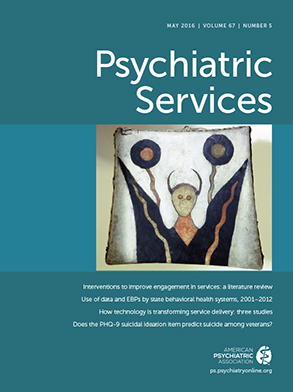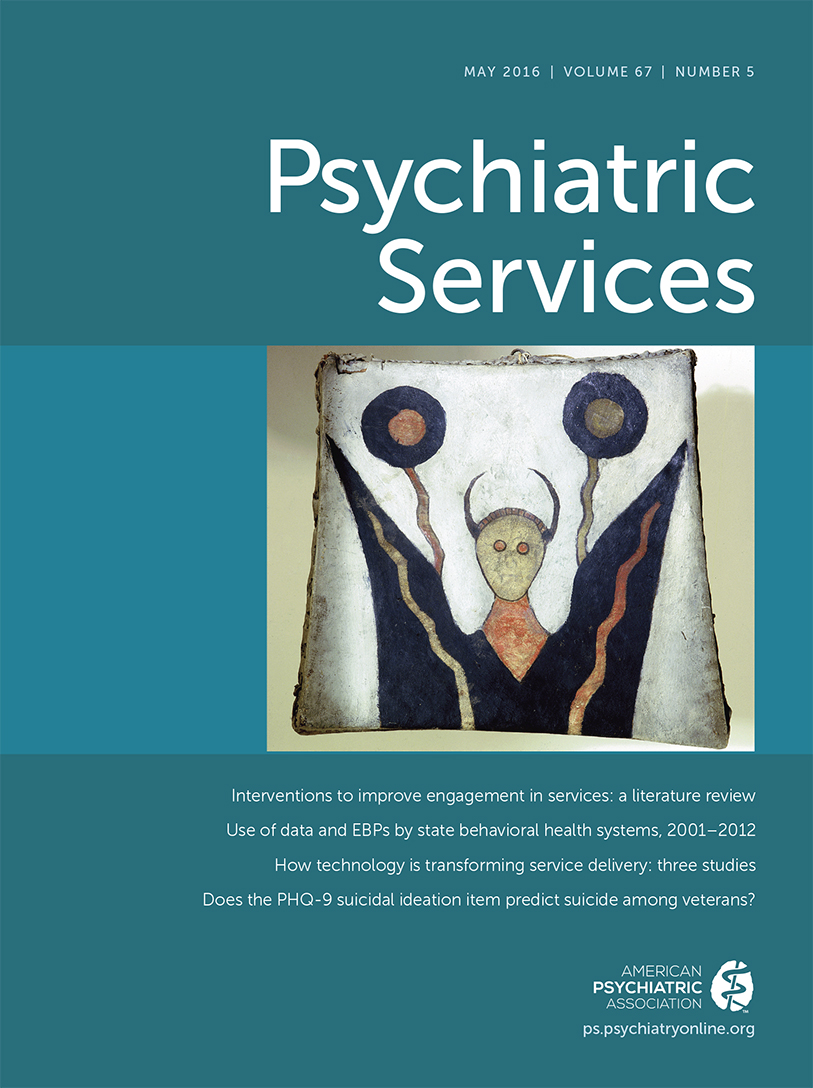Mobile phones are playing a growing role in the modernization of mental health care (
1). Widely available mobile phones can be used to send and receive clinically relevant text messages (
2,
3), administer mental health screening and symptom assessment measures (
4), and support illness management and treatment applications (apps) (
5,
6). Most approaches using mobile phones require individuals to actively engage with the device, for example, by going online, responding to prompts, launching an app, or typing and sending a text. However, mobile phones can also facilitate behavioral tracking techniques that require little or no action by the user.
Mobile phones with significant computational and storage capacity, known as smartphones, have multiple embedded sensors that measure movement, location, acoustics, and ambient light. Sensors can be harnessed to passively capture an abundance of information pertaining to users’ behaviors and environments, so long as individuals carry the device with them (
7). Among populations without psychiatric disorders, mobile behavioral sensing has been used to draw inferences about how and where individuals spend their day (
8) and to track behaviors that are associated with daily stress and changes in mental health over time (
7,
9). A recent study showed that behavioral data captured with smartphone sensing techniques were associated with psychiatric symptoms among persons with bipolar disorder (
10).
Whether individuals with schizophrenia would be willing and able to engage in smartphone behavioral sensing is unclear. To examine the feasibility and acceptability of behavioral sensing in this group, we conducted two proof-of-concept studies among individuals with schizophrenia and schizoaffective disorder. The first study was conducted with a clinically stable sample receiving outpatient care. The second study was conducted with acutely ill hospitalized inpatients. The combined findings have implications for the viability of smartphone sensing as a possible approach for behavioral and contextual tracking among persons with schizophrenia spectrum disorders.
Methods
The research was approved by the Committees for the Protection of Human Subjects at Dartmouth College and the New Hampshire Department of Health and Human Services and the Institutional Review Board at Zucker Hillside Hospital. Participants provided informed consent. Patients were included in this study if they were ages 18 or older and had a chart diagnosis of schizophrenia spectrum disorder. Individuals with a hearing, vision, or motor impairment that made it impossible for them to use a smartphone (assessed on site by study staff) and individuals with a legal guardian were excluded.
Research staff initially contacted candidates by phone (outpatient) or informational visit on the inpatient unit. Research staff met with interested individuals to provide a complete description of the study. Interested individuals reviewed the consent form and were administered a competency screener to verify that they understood what was being asked of them. After giving informed consent, enrolled participants were loaned a smartphone and received a tutorial on how to use different functions, for example, the touch screen and volume control. Participants were asked to keep the smartphone turned on and to carry it with them as they went about their day. Because of hospital safety guidelines, inpatients deposited their device with staff at night, and it was returned fully charged the following day. Sensor data were collected continuously and did not require participant activation. Individuals in the outpatient group participated in two weeks of data collection and were compensated $80. Inpatients participated for one week (just short of the average length of hospitalization) and were compensated $50.
The smartphones were equipped with study software that was developed by our research group. The data collection system consisted of a microphone, multiaxial accelerometers, light sensors, global positioning system (GPS), and a Bluetooth receiver. Data were collected at established intervals or through behaviorally triggered sensor activation (
11). Human speech was captured by the microphone, which was activated every two minutes to capture ambient sound. If speech was detected, the microphone remained active. To protect privacy, the system did not record or transmit audio recordings but instead processed the data in real time, storing features that are useful to infer the presence of human speech (energy, relative spectral entropy, and autocorrelation peak values) but are insufficient to reconstruct speech content (
9,
11). Activity was captured by accelerometers that detected movement. Every two seconds, the system generated and stored an activity rating (active versus sedentary) (
11).
Location was captured differently for the two samples. For outpatients, we used Android location services, which fuse information from the GPS, WiFi, and cellular networks to provide an optimized location estimate. Inpatients, however, typically remained indoors on the same unit during their hospitalization. The few exceptions occurred when patients left the unit to attend therapeutic groups, which included walks outdoors, or to spend time independently in other parts of the hospital. To get a more granular measure of the inpatients’ location, our team installed multiple Bluetooth beacons throughout the inpatient unit, for example, in the halls, nurse station, kitchen, day room or lounge, or group room. The smartphone’s Bluetooth sensor received signals from the beacons, and our study software recorded participants’ locations while they were on the unit and noted when participants left.
The data were stored by the smartphones until they could be securely transmitted to a study server when Internet connectivity was available (nightly for outpatients and at the end of the week for inpatients). All participants returned the smartphones and completed a questionnaire comprising adapted items from several acceptability or usability measures before receiving compensation (
5).
Results
Nine outpatients were approached for the study, and all agreed to participate and were successfully enrolled (males, N=6, 67%; whites, N=5, 56%; mean±SD age=39±12). Twenty inpatients were approached for the study, seven declined to participate, and three stated that they were apprehensive about being monitored by tracking technology. The remaining 13 were interested in participating, but two were excluded because they did not pass the competency screener, leaving 11 participants (males, N=10, 91%; whites, N=6, 55%; mean age=38±12). The final overall sample consisted of 20 participants, of whom 12 (60%) were diagnosed as having schizophrenia and eight (40%) as having schizoaffective disorder. [A table describing additional demographic and clinical information about the participants is available as an online supplement to this report.]
All enrolled participants completed the study and filled out the usability and acceptability questionnaire. One outpatient did not charge the smartphone regularly and sensor data collected from his device indicated that it rarely moved throughout the data collection period, suggesting poor adherence to the study protocol.
Sensor data showed that on average, outpatients were active (nonsedentary) for 2.5±7.4 hours and were proximal to human speech for 4.4±4.2 hours per day. Speech and activity patterns varied across individuals; some were more engaged in the morning and others in the evening. On average, they traveled 9.3±13.5 miles per day and spent 16.7±6.7 hours per day in the same location. Outpatients used the smartphone to send an average of 4.5±6.1 text messages and make 7.2±8.4 calls daily, with each call averaging 16.8±6.7 minutes (these functions were disabled for inpatients because of hospital regulations). Except for one individual, outpatients charged the phone, on average, twice daily, suggesting good adherence to the study protocol.
Inpatients picked up the smartphones in the morning and returned them at night at slightly different times. For consistency, we report on sensor data collected between 8 a.m. and 8 p.m. In general, inpatients were active (nonsedentary) for 2.1±1.4 hours per day and were proximal to human speech for 4.4±2.0 hours per day. They spent 5.5±6.0 hours in the men’s and women’s halls, where they were proximal to human speech for .9±1.8 hours and were active 25% of the time per participant; 2.1±4.4 hours near the nurse station, where they were around human speech for .7±1.7 hours and were active 32% of the time; .9±1.8 hours in the kitchen, where they were around human speech for .4±.9 hours and were active 30% of the time; .5±1.4 hours in the day room or lounge, where they were around human speech for .2±.6 hours and were active 29% of the time; and .7±1.5 hours in the group room, where they were around human speech for .2±.7 hours and were active 48% of the time. In summary, inpatients spent the most time in the halls, were most active in the group room, and spent the most amount of time around human speech at the nurse station.
Combined responses by both groups to the usability or acceptability measure indicated that 19 (95%) felt comfortable using the smartphone sensing system, 14 (70%) understood how it worked, 14 (70%) did not have difficulty keeping the device with them at all times, and 13 (65%) would be interested in receiving system-generated feedback or suggestions if they were distressed (
Table 1). Four participants indicated that smartphone sensing made them upset. Four inpatients were concerned about a loss of privacy, but no outpatients expressed such concerns.
Discussion
To our knowledge, this is the first report that describes the feasibility and acceptability of multimodal smartphone sensing for behavioral and contextual tracking among outpatients and inpatients with schizophrenia. The majority of individuals approached for the study expressed interest in participating and adhered to the study protocol. Most participants reported feeling comfortable with this technique and did not experience distress or negative outcomes. Approximately two-thirds indicated that they would be interested in receiving summary reports, feedback, and suggestions from the smartphone system.
Previous studies have shown that people with schizophrenia can use mobile technologies to self-report behaviors and functioning (
12,
13). The current research extends these findings by demonstrating that individuals with schizophrenia, including acutely ill hospitalized patients, can engage in passive sensing facilitated by widely available smartphones. The methods used in this research are less vulnerable to many of the challenges associated with self-report paradigms, including problems with low literacy, self-presentation biases, poor insight or attention, and motivational difficulties, for example, not responding to prompts. Excluding battery charging periods, the smartphone collected a wealth of objective information automatically and continuously, providing a multidimensional and vivid longitudinal depiction of users’ behaviors, location, and social environments.
The research had several limitations. Data collection was dependent on participants’ carrying the smartphone. If participants forgot the device or loaned it to others, the data captured for that period would not represent the intended user’s activity and environment. In addition, location could not be determined when outpatients were indoors (no GPS data) or out of WiFi or cellular network range and when inpatients left the unit that had been fitted with Bluetooth beacons.
Conclusions
Individuals with schizophrenia were willing and able to engage in behavioral sensing using smartphones. More than 50% of the adult population in the United States already owns and uses smartphones regularly, and recent research suggests that individuals with psychiatric illnesses are not dramatically different in this regard (
14). Wearable sensing technologies, such as bracelets or garments, require that users be motivated enough to want a specialized device and be able to afford it (
15). With the aid of software that can repurpose smartphone sensors, these ubiquitous devices can be leveraged as objective, affordable, and scalable behavioral measures. Used effectively and with appropriate protection of patient privacy, access to behavioral sensing data could potentially transform clinical decision making and practice.
Acknowledgments
The authors thank Sandra Gary, B.S.N., R.N.-B.C., Jeffrey Schou, A.S.H.S., and Marjorie Weeks, M.P.A., for assistance in conducting the study with inpatients at New Hampshire Hospital. They thank Susan Ray, M.S., for her role in participant recruitment and training of outpatients at Zucker Hillside Hospital.

